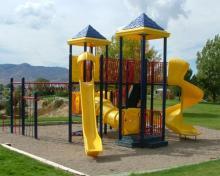
Fall height is a measurement defined as the “vertical distance between a designated play surface and the protective surfacing beneath it.”1
Fall height measurements vary according to the type of play equipment. On climbing equipment, the fall height is measured from the highest part of the climber intended for foot support. The fall height for upper body equipment is measured from the highest part of the equipment, not including support posts with no designated play surface. The fall height for swings is measured from the pivot point. The fall height of see-saws is the maximum height attainable by the seat and the fall height of spring rockers is the height of the seat. Specific information on fall height for different types of play equipment components can be found in Section 8 of ASTM Standard F1487-11.2 On a composite piece of playground equipment where the components are connected, the fall height for the entire unit is the distance from the highest designated play surface to the protective surface.3
Fall height is a measurement of distance between a play surface and the protective surface. Critical height relates to the impact attenuation of the surface material and is “the maximum height from which a life threatening head injury would not be expected to occur.”4 Therefore, the fall height of the equipment should not exceed the critical height of the surface in the design of playgrounds and the type and depth of surfacing used under the equipment. Playground designers are aware of safety issues including fall heights and critical heights as they relate to playgrounds.
- 1. ASTM International Standard F1292, “Standard Specification for Impact Attenuation of Surfacing Materials Within the Use Zone of Playground Equipment,” 3.1.3, p. 2.
- 2. ASTM International Standard F 1487-11, “Standard Consumer Performance Specification for Playground Equipment for Public Use,” Section 8, pp. 10-15.
- 3. U.S. Consumer Product Safety Commission (CPSC) Publication #325-10, “Public Playground Safety Handbook,” p. 4.
- 4. Op. cit., ASTM F1292, 3.1.1, p. 2.

